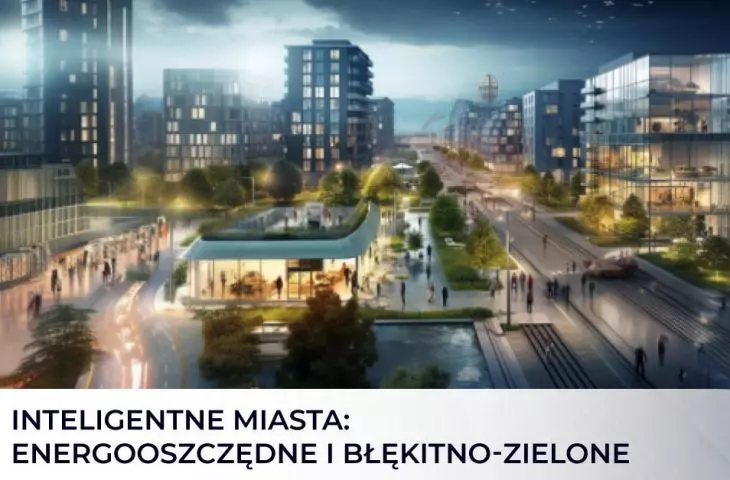In a ranking of the most and least liveable cities compiled this year by The Economist Intelligence Unit, Vienna, one of the European leaders in implementing the Smart City concept, came in first place. What can we do to make a similar transformation happen in Polish cities?
In transforming cities into "smart" cities, the important things are:
- increasing the energy efficiency of buildings, which should be the priority of users, owners, designers and contractors;
- striving for energy independence of buildings as a powerful impetus for innovation and economic development;
- financial support from the state budget and EU funds for investors;
- retention of water for domestic use in cities, instead of focusing solely on rainwater drainage systems.
Each of these topics will be discussed by experts at the Smart City Forum congress, which will be held on November 20 and 21 at The Westin Warsaw Hotel.
ways to improve the energy efficiency of buildings
Energy efficiency - the degree to which buildings are prepared to provide thermal comfort to their occupants - has a direct impact on energy savings and the amount of pollutants emitted into the atmosphere (greenhouse gases and particulate matter), as well as on budget spending. What can improve the energy efficiency of buildings is thermal modernization. Treatments aimed at reducing the energy demand for heating/cooling buildings and preparing hot water include:
- replacement or modernization of heating systems,
- insulating the building envelope and roofs, ceilings and floors,
- ensuring the tightness of windows, doors and garage doors,
- replacing lighting and appliances with energy-efficient ones.
It is also important not to waste energy and to take even the smallest actions every day, such as turning off unused appliances or cooking with a lid.
Building trends that help improve energy efficiency
Practical tips can be found in the Ministry of Development and Technology's September 2023 publication "Improving the Energy Performance of Buildings. Guidebook." The advice collected in it is intended to help designers and contractors create low-energy, environmentally and climate-friendly buildings. It is worth mentioning such examples as paying attention to the high thermal insulation of the building envelope, designing efficient heating, ventilation and lighting systems using RES, eliminating thermal bridges or not being satisfied with just meeting the minimum energy efficiency requirements of technical and construction regulations.
A noteworthy trend is also natural construction, which uses materials such as wood, stone, clay, straw or hemp. They are distinguished by their low embedded energy, i.e. requiring little energy to produce and prepare for use in a building. Such materials can also often be locally sourced, which reduces their carbon footprint, reused or biodegradable.
Financing energy-efficient construction and the use of RES
Investors implementing energy-efficient construction and the use of renewable energy sources (RES) can count on financial support, for example, through the "Clean Air" and "My Current" programs, the possibility of receiving subsidies from the Thermomodernization and Renovation Fund, the thermo-modernization tax credit, the "Stop Smog" program and low emission reduction programs.
Does it make sense to pursue energy independence for buildings?
Designing and building energy-independent properties that draw their energy primarily from renewable sources is in line with the general course of action expected of member states under Directive 2010/31/EU. The goal of updating EU guidelines is to maximize savings in capital expenditures and operating costs over the entire life cycle of a building.
Increasing energy efficiency not only prevents irretrievable energy losses, but also stimulates the development of innovative technologies. According to the aforementioned guidebook, this provides a boost to the economic progress of individual cities and regions, and consequently the entire economy.
sponge cities
Rapid rainfall resulting from climate change is a serious problem for gated urban spaces - rainwater has nowhere to go, causing flash floods and flooding. The answer to impermeable surfaces in cities and low capacity of sewerage systems is to be found in the concept of the "sponge city"(spongecity), which involves transferring to urban water management solutions observed in nature for storing and giving away water resources. This makes it possible not only to prevent flooding and waterlogging, but also to retain rainwater for urban use.
The concept can be implemented mainly through the development of green and blue infrastructure, not only the revitalization and establishment of urban parks, flower meadows, ponds, retention basins, rain gardens or other green areas characterized by high permeability of the surface, but also modern, innovative and environmentally friendly solutions in construction.
Examples of implementation can already be seen in Polish cities - in Katowice, more than 115 meters of sewage network and a system of retention tanks with a capacity of as much as 437.5 m³ have been built, and thestored water the City intends to use, among other things, for watering urban greenery and cleaning streets; Krakow decided to revitalize Duchacki Park to reduce flooding and waterlogging. As part of the investment, the pond system was divided into two parts - the upper one creates good conditions for biodiversity development, while the lower one has a retention and recreational function.
Smart City as an answer to the most pressing problems
Countering environmental degradation and global warming or energy security for citizens and entire countries are just a few of the extremely topical challenges. Implementation of the Smart City concept is perfectly in line with preventive measures that can be taken by city councils and local governments, and the participants of the 17th edition of the Smart City Forum will discuss specific examples of ways to implement them.














